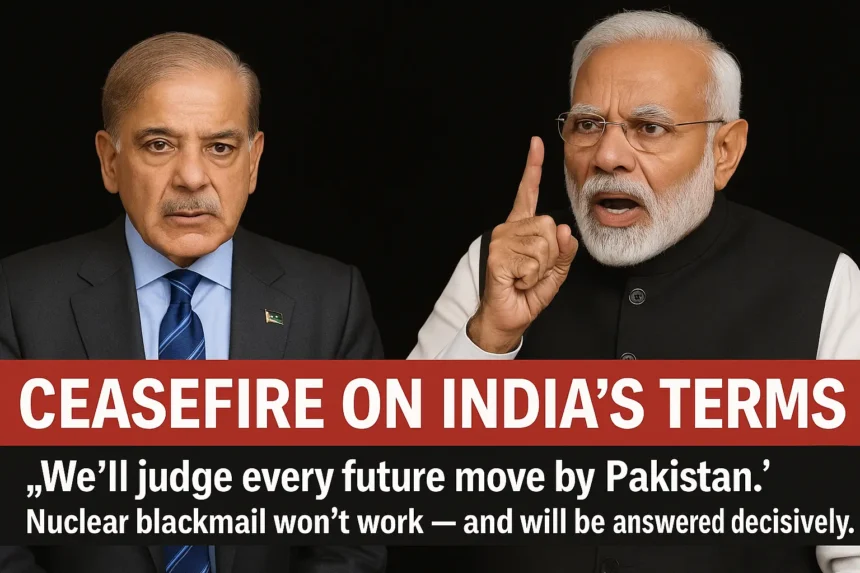Facts on Ceasefire Deal: Why PM Modi Called the Ceasefire a Strategic Victory After Pahalgam Attack
In a powerful address to the nation, Prime Minister Narendra Modi broke his silence on the recent ceasefire agreement with Pakistan following the horrific Pahalgam terror attack. What followed wasn’t just a military retaliation — it was a turning point in India’s national security strategy. With Operation Sindoor, India delivered a precise and devastating blow to Pakistan’s terror infrastructure.
But what sparked global attention wasn’t just the military action — it was the sudden ceasefire. Why did India, after such a massive retaliation, agree to a truce? PM Modi finally revealed the answers.
“Pakistan Struck, We Hit Back Harder” – PM Modi
Pakistan chose to attack not just India’s military posts but also civilian institutions — schools, temples, homes, and places of worship. Instead of joining the global fight against terrorism, it chose violence.
What Pakistan didn’t anticipate was India’s overwhelming response. “Their drones and missiles fell like paper planes,” said PM Modi. India’s advanced air defense system intercepted every threat.
India didn’t retaliate for show — it hit Pakistan’s military and terror infrastructure with pinpoint precision, bringing them to their knees within 72 hours.
Operation Sindoor: The Turning Point
The Indian Army launched Operation Sindoor, a swift and targeted mission that destroyed key terror camps and strategic military installations in Pakistan-occupied Kashmir (PoK). Unlike past operations, this wasn’t a symbolic show of strength — this was full-scale tactical dominance.
“Our missiles hit their pride — their key airbases. Our drones shattered their confidence,” Modi said.
3 Alarming Facts About the Pakistan Ceasefire Deal
1. Pakistan Requested the Ceasefire, Not India
After suffering massive destruction from Operation Sindoor, it was Pakistan that contacted India’s DGMO on May 10, pleading for a ceasefire. India hadn’t stepped back — Pakistan had given up.
2. India Has Only Paused, Not Ended, Military Action
PM Modi emphasized that the action has only been “suspended,” not canceled. Any future attack or provocation will lead to stronger retaliation. India holds the remote.
3. Terrorists and State Will Be Treated Equally
For the first time, India declared it will not distinguish between terror groups and the government that supports them. That means Pakistan’s government and military infrastructure are now legitimate targets.
Why the Ceasefire Happened: The Truth Behind It
PM Modi clarified that the ceasefire wasn’t an act of peace — it was a calculated pause. India agreed only after Pakistan committed to ending all terror activities and cross-border military aggression.
“After we dismantled their terror bases, they begged for a way out,” Modi said. Pakistan was under pressure globally and cornered militarily. That’s when they reached out to de-escalate.
India listened, not out of weakness, but because its mission objectives were achieved — for now.
Ceasefire on India’s Terms
PM Modi made it clear: this is not a peace agreement. It’s a strategic halt.
“We’ll judge every future move by Pakistan,” he warned. “Any sign of terror, and our response will be swifter and stronger.”
India’s armed forces are on high alert. The air force, navy, army, and intelligence agencies are watching every step across the border and beyond.
The New Anti-Terror Policy: Operation Sindoor
This operation wasn’t just a military action; it was a policy declaration. India’s new anti-terror doctrine is now built around proactive, preemptive, and punitive strikes. No warning. No delay.
From surgical strikes in 2016 to Balakot in 2019 — Operation Sindoor has set a new benchmark.
PM Modi declared. “Terror will not be tolerated, and support for terror will be punished.”
PM Modi’s 3 Final Warnings to Pakistan
PM Modi concluded his address with three sharp, non-negotiable warnings:
- Any terror attack will be met with direct and devastating retaliation.
- Nuclear blackmail won’t work — and will be answered decisively.
- India will target both terrorists and the governments that protect them.
There’s no ambiguity left — India is no longer playing defense; it’s enforcing deterrence.
Final Thoughts: Ceasefire Is Just a Pause — Not the End
India’s ceasefire with Pakistan isn’t a sign of weakness but a strategic pause. After the success of Operation Sindoor, which struck Pakistan’s terror infrastructure, India chose to temporarily halt its operations. Prime Minister Modi’s message is clear: the silence following the ceasefire is not peace — it’s a test. It’s a test to see whether Pakistan will honor its commitment to stop terrorism and military provocations.
India remains on high alert, ready to respond to any sign of aggression. This ceasefire is a temporary measure, and India’s military readiness is stronger than ever. The message to Pakistan is simple: any further attempts to escalate or support terrorism will be met with decisive action. India has made its position clear — it won’t back down. The world is watching, and the next steps will depend on Pakistan’s actions.
Want to stay updated on India’s evolving national security strategy?
Subscribe now for sharp, in-depth insights on defense, diplomacy, and what’s next on the Indo-Pak front.
Most read: https://tnheadlines24.com/fears-pakistan-faced-after-indias-missile/
Disclaimer: TN HEADLINES24 is not responsible for the views and claims made in this article. The content is based on public statements and media reports for informational purposes only.








